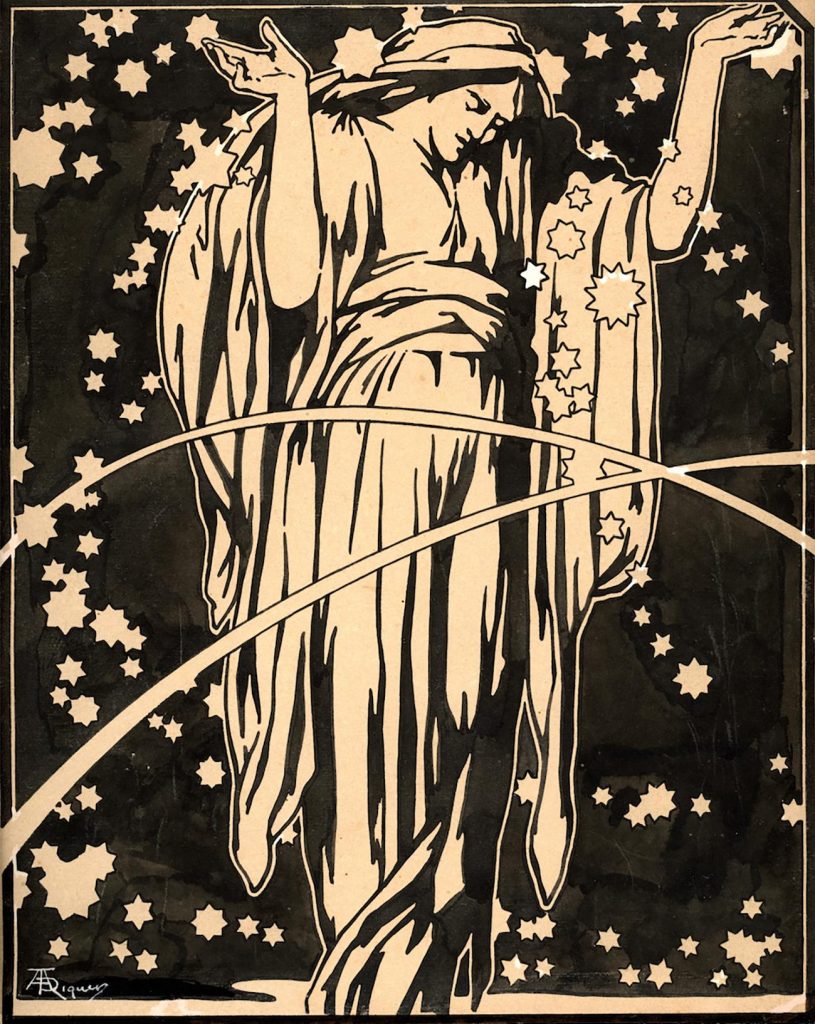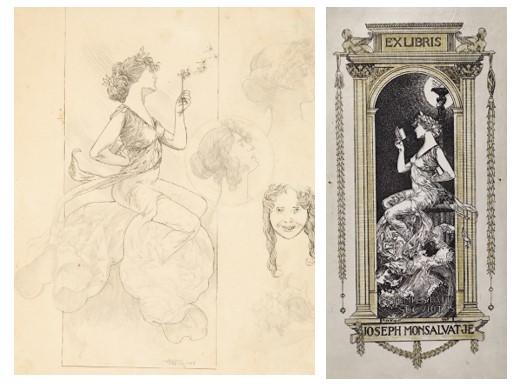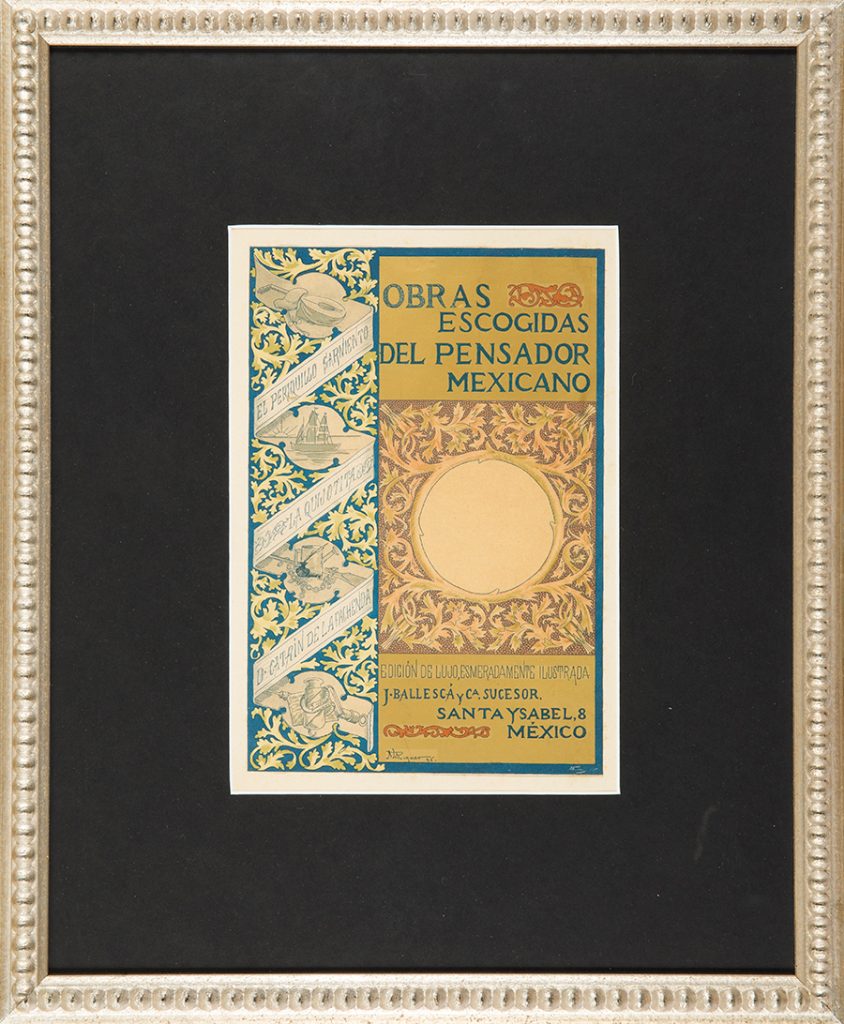The collection: The unpublished legacy of Alexandre de Riquer.
There are collections capable of imbuing us with the spirit of a particular era. In the case we present to you, we are transported to a time when books, illustration and poster art represented true jewels of collecting.
The group of works gathered at auction, among which we can find original illustrations, ex libris cover projects or lithographic posters and their originals, represents an invaluable testimony of the excellence that these artistic disciplines reached during Modernism, thanks to artists who, like Riquer, renewed and gave prestige to them.


Likewise, the research carried out on the unpublished legacy of the artist in tender, has revealed new information unknown until now. Among them, it stands out that the project for the cover of the book Astronomía Popular, in tender and, until now, attributed to Triadó, was, in fact, made by Riquer and adapted, later, to the editorial needs by Triadó. Another finding, which has been revealed thanks to the study of the collection, is that Julia Peraire, the iconic muse that Ramon Casas met in 1905, was previously Riquer’s model.
Another finding, which has been revealed thanks to the study of the collection, is that Julia Peraire, the iconic muse that Ramon Casas met in 1905, was previously Riquer’s model. In fact, it was in 1902 when Peraire posed for the first time for Riquer, becoming the model of an ex-libris made for Raimon Casellas.
It is also worth mentioning the set of four lithographic posters of “The Four Seasons”, of which few copies have survived to the present day. In fact, there is no public institution in this country that has copies of this artistic production, so important in Alexandre de Riquer’s career as an illustrator. Equally interesting are the “Printing proofs of the Prospectus of the Exlibris A. de Riquer” of 1903, the pencil and ink drawing “Modernist lady with dandelion”, or the cover project of the book “For them. Collection of Novelitas and original stories by Adela Sánchez Cantos de Escobar (1896).

Alexandre de Riquer and the rebirth of graphic arts
With the emergence of modernism, the graphic arts, in all their breadth, experienced a real rebirth, thanks to artists such as Alexandre de Riquer, who marked the cultural pulse of the time. Through his illustrations, both of books and magazines, as well as posters, this multifaceted artist molded and chiseled the aesthetics of Catalan modernism, until he became the author of some of the most iconic images of the movement.
In fact, few figures embody the spirit of the times in the way that Riquer did. The training he acquired through his trips to London, Rome or Paris, together with the deep knowledge of English art, which he was able to extract thanks to the art library he treasured, unique in Spain, place him, undoubtedly, as its most international representative.
In this sense, Riquer will give light to his work, under the spell of English aestheticism, whose influence can be seen in each of the facets that the artist developed. The sophistication and symbolism of the Pre-Raphaelites, together with the delicacy of refined Japanese art, were decisive in the creative direction of Riquer and, by extension, of Catalan modernism. In his posters, illustrations and ex-libris, the female figure will become the central element, often accompanied by a symbolic decoration of curved forms and vegetal elements. In this aspect, the impact exerted by japonism is evident, whose technique he adopted with fervor, through vertical compositions, as well as in the vegetal symbology, and the use of flat inks and outlined drawings.
But how can we explain the boom in the graphic arts during this period? There is no doubt that the Industrial Revolution significantly accelerated graphic production. With the arrival of the industrial era, modern advertising was also born, the Catalan Renaixença and a new social class, which became a key factor in the development and proliferation of these artistic techniques. The Catalan bourgeoisie, in addition to promoting consumer production and, therefore, advertising poster competitions, also vied to obtain what in other times belonged to the aristocracy: libraries, works of art and ex-libris became the object of desire of this new social class. Beyond their undoubted artistic value, these works are of great historical relevance, as testimony to what was the period of maximum splendor of the Catalan graphic arts and the recovery of traditional practices and trades. This creative effervescence would not have been possible without a society with a deeply rooted cultural awareness, in which reading and the cult of books were widely shared and assumed values.


Within this context, artists of the time such as Riquer put all their talent into the development of these arts, both in terms of exlibrismo, as well as poster design and book illustration, elevating them to the category of artistic objects. Despite the oblivion in which, for a time, his figure fell, little by little and especially from the 50’s onwards, Riquer’s significance has recovered the true dimension that his legacy well deserves.










